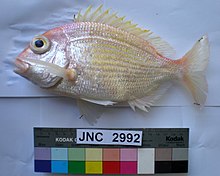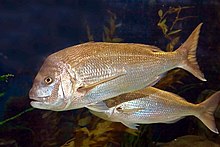| Sparidae Temporal range: Early Eocene to present PreꞒ Ꞓ O S D C P T J K Pg N | |
|---|---|

| |
| Gilt-head bream (Sparus auratus) | |
| Scientific classification | |
| Domain: | Eukaryota |
| Kingdom: | Animalia |
| Phylum: | Chordata |
| Class: | Actinopterygii |
| Order: | Acanthuriformes |
| Family: | Sparidae Rafinesque, 1810 |
| Genera | |
|
see text | |
| Synonyms | |
| |
Sparidae is a family of ray-finned fishes belonging to the order Spariformes, the seabreams and porgies, although they were traditionally classified in the order Perciformes. They are found in shallow temperate and tropical waters around the world and are demersal carnivores.
Taxonomy
Sparidae was first proposed as a family in 1818 by the French polymath and naturalist Constantine Samuel Rafinesque. Traditionally the taxa within the Spariformes were classified within the Perciformes, with some authorities using the term "Sparoid lineage" for the families Centracanthidae, Nemipteridae, Lethrinidae and Sparidae. Since then the use of molecular phylogenetics in more modern classifications has meant that the Spariformes is recognised as a valid order within the Percomorpha containing six families, with Callanthidae, Sillaginidae and Lobotidae included. Other workers have found that the Centracanthidae is synonymous with Sparidae and that the Spariformes contains only the remaining three families of the "Sparoid lineage".
In the past workers recognised six subfamilies within the Sparidae. These were Boopsinae, Denticinae, Diplodinae, Pagellinae, Pagrinae, and Sparinae. However, these taxa did not resolve as monophyletic in all the analyses undertaken. These analyses support Sparidae as a monophyletic family if Spicara, a genus formerly in the family Centracanthidae, was included. This meant that Spicara and Centracanthus were both now classified within Sparidae, so that Centracanthidae is a junior synonym of Sparidae.
Etymology
Sparidae takes its name from its type genus, Sparus, that name coming from the Greek for its only species the gilt-head bream (Sparus aurata).
Genera



The family Sparidae contains about 155 species in 38 genera:
- Acanthopagrus Peters, 1855
- Amamiichthys F. Tanaka & Iwatsuki, 2015
- Archosargus Gill, 1865
- Argyrops Swainson, 1839
- Argyrozona J. L. B. Smith, 1938
- Boops Cuvier, 1814
- Boopsoidea Castelnau, 1861
- Calamus Swainson, 1839
- Centracanthus Rafinesque, 1810
- Cheimerius J. L. B. Smith, 1938
- Chrysoblephus Swainson, 1839
- Crenidens Valenciennes, 1830
- Cymatoceps J. L. B. Smith, 1938
- Dentex Cuvier, 1814
- Diplodus Rafinesque, 1810
- Evynnis D. S. Jordan & W. F. Thompson, 1912
- Gymnocrotaphus Günther, 1859
- Lagodon Holbrook, 1855
- Lithognathus Swainson, 1839
- Oblada Cuvier, 1829
- Pachymetopon Günther, 1859
- Pagellus Valenciennes, 1830
- Pagrus Cuvier, 1816
- Parargyrops S. Tanaka, 1916
- Petrus J. L. B. Smith, 1938
- Polyamblyodon Norman, 1935
- Polysteganus Klunzinger, 1870
- Porcostoma J. L. B. Smith, 1938
- Pterogymnus J. L. B. Smith, 1938
- Rhabdosargus Fowler, 1933
- Sarpa Bonaparte, 1831
- Sparidentex Munro, 1948
- Sparodon J. L. B. Smith, 1938
- Sparus Linnaeus, 1758
- Spicara Rafinesque, 1810
- Spondyliosoma Cantor, 1849
- Stenotomus Gill, 1865
- Virididentex Poll, 1971


Fossil genera include:
- †Abromasta Day, 2003
- †Burtinia van Beneden, 1873
- †Crommyodus Cope, 1875
- †Ctenodentex Storms, 1896
- †Ellaserrata Day, 2003
- †Kreyenhagenius David, 1946
- †Paracalamus Arambourg, 1927
- †Plectrites Jordan & Gilbert, 1920
- †Pseudosparnodus Day, 2003
- †Pshekharus Bannikov & Kotylar, 2015
- †Rhythmias Jordan & Gilbert, 1920
- †Sciaenurus Agassiz, 1845
- †Sparnodus Agassiz, 1838
Characteristics
Sparidae breams have oblong, moderately deep and compressed bodies. The head is large, with a characteristic steep dorsal slant. There are no scales on the snout but there are scales on the cheeks. The preoperculum may or may not have scales and has no spines or serrations on its margin. The operculum is scaled and also has no spines. The mouth is slightly oblique and can be protruded a little. The upper jaw never extends back past a vertical line through the centre of the eye. There are teeth in the jaws which vary from conical or flattened but there are no teeth on the roof of the mouth. There is one dorsal fin which is supported by between 10 and 13 spines and 9 and 17 soft rays, with the ultimate ray being split into 2, and no incision separated the spines from the soft rays. The rearmost spines in the dorsal fin may be elongated or filamentous. The anal fin is supported by 3 robust spines and between 7 and 15 soft rays. The caudal fin varies from moderately deeply emarginate to forked. The pectoral fins are typically long and pointed and the pelvic fins are under or immediately to the rear of the bases of the pectoral fins, supported a single spine and 5 soft rays, with a scale in the axilla, referred to as the axillary pelvic process. The scales are typically smooth, cycloid, or slightly rough to the touch, weakly ctenoid, The lateral line is single and continuous and reached the base of the caudal fin. They are very variable in colour and may be pinkish or reddish to yellowish or greyish, frequently with tints of silver or gold and dark or coloured spots, stripes or bars. The two largest species of Sparid are the white steenbras (Lithognathus lithognathus) and the red steenbras (Petrus rupestris), both of which have a maximum published total length of 200 cm (79 in), while the smallest species is the cherry seabream (Polysteganus cerasinus).
Distribution and habitat
Sparidae breams are found in tropical and temperate coastal waters around the world. They are demersal fishes on the continental shelf and slope. A few species are found in brackish water, and a few of these will enter fresh water.
Biology
Sparidae breams are predatory with most feeding on benthic invertebrates. Smaller species in the family usually gather in schools, as do the juveniles of the larger species. The larger adult fishes are normally solitary or, at least, are less sociable and prefer deeper waters. The juveniles and subadults are often markedly different in shape and colour patterns, and may be much more colourful. Many sparids are hermaphroditic and some have both male and female sex organs at the same time. Others change sex as the grow, either changing from male to female, i.e. protandrous. or from female to male, protogynous.
Fisheries
Sparids are highly regarded as food fish and are important target species for commercial fisheries wherever they occur. Between 1990 and 1995, the FAO Yearbook of Fishery Statistics reported that the annual weight of landings was between 2,170 and 4,020 t (2,140 and 3,960 long tons; 2,390 and 4,430 short tons) of sparids in the Western Central Pacific.
Cookery
The most celebrated of the breams in cookery are the gilt-head bream and the common dentex.
See also
References
- ^ Richard van der Laan; William N. Eschmeyer & Ronald Fricke (2014). "Family-group names of recent fishes". Zootaxa. 3882 (2): 1–230. doi:10.11646/zootaxa.3882.1.1. PMID 25543675.
- ^ Nelson, J.S.; Grande, T.C.; Wilson, M.V.H. (2016). Fishes of the World (5th ed.). Hoboken, NJ: John Wiley & Sons. pp. 502–506. doi:10.1002/9781119174844. ISBN 978-1-118-34233-6. LCCN 2015037522. OCLC 951899884. OL 25909650M.
- Kent E. Carpenter and G. David Johnson (2002). "A phylogeny of sparoid fishes (Perciformes, Percoidei) based on morphology". Ichthyological Research. 49 (2): 114–127. doi:10.1007/s102280200015.
- Ricardo Betancur-R; Edward O. Wiley; Gloria Arratia; et al. (2017). "Phylogenetic classification of bony fishes". BMC Evolutionary Biology. 17 (162): 162. Bibcode:2017BMCEE..17..162B. doi:10.1186/s12862-017-0958-3. PMC 5501477. PMID 28683774.
- "Order SPARIFORMES: Families LETHRINIDAE, NEMIPTERIDAE and SPARIDAE". The ETYFish Project Fish Name Etymology Database. Christopher Scharpf. 17 October 2022. Archived from the original on 30 October 2023. Retrieved 18 December 2023.
- Tanaka, F.; Iwatsuki, Y. (2015). "Amamiichthys, a new genus for the sparid fish Cheimerius matsubarai Akazaki 1962, and redescription of the species, with designation of a neotype". Zootaxa. 4007 (2): 195–206. doi:10.11646/zootaxa.4007.2.3. PMID 26623801.
- "PBDB Taxon". paleobiodb.org. Retrieved 2024-04-03.
- Carnevale, G.; Bannikov, Alexandre F.; Marramà, G.; Tyler, James C.; Zorzin., R. (2014). "The Bolca Fossil-Lagerstätte: A window into the Eocene World. 5. The Pesciara- Monte Postale Fossil-Lagerstätte: 2. Fishes and other vertebrates. Excursion guide" (PDF). Rendiconti della Società Paleontologica Italiana. 4 (1): i–xxvii. hdl:10088/25678.
- Day, Julia J. (2002). "Evolutionary relationships of the Sparidae (Teleostei: Percoidei): integrating fossil and Recent data". Earth and Environmental Science Transactions of the Royal Society of Edinburgh. 93 (4): 333–353. doi:10.1017/S0263593300000468. ISSN 1473-7116.
- Dobbels, Leon (1994). "Soortenlijst van fossiele vissen uit het Eoceen van België" (PDF). Afzettingen WTKG. 15 (4).
- David, Lorre R. (1946). "Some Typical Upper Eogene Fish Scales from California". Contributions to Paleontology. IV.
- ^ K.E. Carpenter (2001). "Sparidae". In Carpenter, K.E. and Niem, V.H. (eds.). FAO species identification guide for fishery purposes. The living marine resources of the Western Central Pacific. Volume 5. Bony fishes part 3 (Menidae to Pomacentridae) (PDF). FAO Rome. p. 2990.
- ^ Froese, Rainer; Pauly, Daniel (eds.). "Family Sparidae". FishBase. October 2023 version.
- Yukio Iwatsuki and Phillip C Heemstra (2022). "Family Sparidae". In Phillip C Heemstra; Elaine Heemstra; David A Ebert; Wouter Holleman; and John E Randall (eds.). Coastal Fishes of the Western Indian Ocean (PDF). Vol. 3. South African Institute for Aquatic Biodiversity. pp. 284–315. ISBN 978-1-990951-32-9.
- Davidson, A. Mediterranean Seafood, Penguin, 1972. ISBN 0-14-046174-4, pp. 86–108.